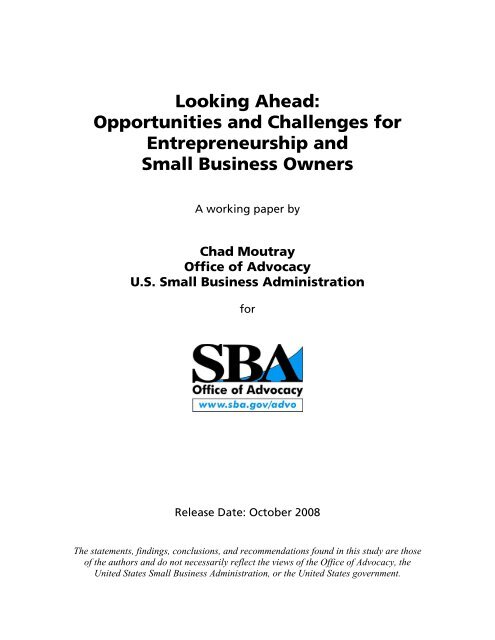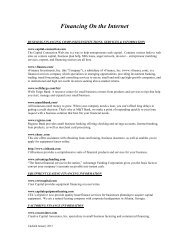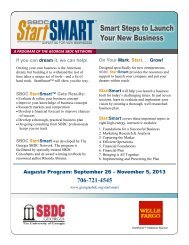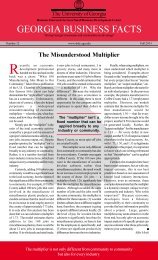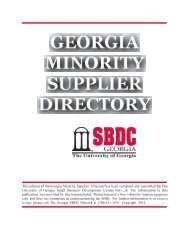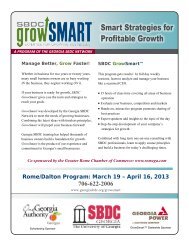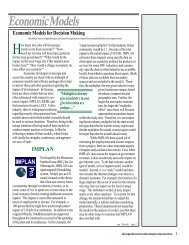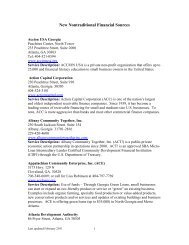Looking Ahead - Georgia Small Business Development Center
Looking Ahead - Georgia Small Business Development Center
Looking Ahead - Georgia Small Business Development Center
Create successful ePaper yourself
Turn your PDF publications into a flip-book with our unique Google optimized e-Paper software.
<strong>Looking</strong> <strong>Ahead</strong>:Opportunities and Challenges forEntrepreneurship and<strong>Small</strong> <strong>Business</strong> OwnersA working paper byChad MoutrayOffice of AdvocacyU.S. <strong>Small</strong> <strong>Business</strong> AdministrationforRelease Date: October 2008The statements, findings, conclusions, and recommendations found in this study are thoseof the authors and do not necessarily reflect the views of the Office of Advocacy, theUnited States <strong>Small</strong> <strong>Business</strong> Administration, or the United States government.
October 2008 No. 332<strong>Looking</strong> <strong>Ahead</strong>: Opportunities and Challenges forEntrepreneurship and <strong>Small</strong> <strong>Business</strong> OwnersAn Office of Advocacy Working Paperby Chad Moutray [19] pages.This paper was prepared for presentation at“Entrepreneurship in a Global Economy,”a conference sponsored by the Western NewEngland College’s Law and <strong>Business</strong> <strong>Center</strong> forAdvancing Entrepreneurship, held in Springfield,Massachusetts, on October 17, 2008.PurposeThis paper outlines the most important issues andopportunities facing small business owners andentrepreneurs in this election year. While it does notdelve into policy solutions, the next administrationwill almost certainly need to address many of them,regardless of who wins the presidency.ChallengesThe paper outlines five major challenges that smallbusiness owners will face in the coming years.• Strengthening the Overall Economy. <strong>Small</strong>businesses continue to struggle in the economicdownturn, and it will be important for policy leadersto get the economy moving again. <strong>Small</strong> businesseswill be a large part of that, as entrepreneurs willspur new innovation and employment in the comingyears. These firms will continue to be the jobgeneratorsthat we have become accustomed to. Withthat said, industries will recover from the downturnin different ways, and some industries have clearlybeen hit harder this time than in past business cycles.• Taxes and Regulation. <strong>Business</strong> conditionshave a fundamental impact on entrepreneurial activity,and small business owners frequently cite tax andregulatory policies as a concern. Moving forward, itwill be important for policymakers to consider theimpact of taxes and regulations on small businessowners and would-be entrepreneurs.• Cost and Availability of Health Insurance.Health insurance premiums have risen substantiallyin this decade. The Kaiser Family Foundation reportsthat the cost of employee-sponsored health insuranceplans has increased 119 percent since 1999. It is alsowell-documented that employees at smaller firmsare less likely to be offered health care coverage.Finding ways to control the cost of providing healthinsurance to employees and increasing coverage willremain a priority for our national and state leaders.• Attracting and Retaining a QualityWorkforce. <strong>Small</strong> businesses must compete forlabor with their larger counterparts. This is more difficultin light of the disparity in total compensation,especially benefits, and the result is greater employeeturnover. Demographic trends in the coming yearsmight also exacerbate these challenges.• Global Competition. American businesses facecompetitors on a number of fronts, both at home andabroad. The U.S. government has worked to increasethe ability of our firms to compete overseas by loweringtrade barriers. There are also some structuraldisadvantages that work to make our products lesscompetitive, and many companies have reducedtheir costs by outsourcing some processes and tasksabroad. While insourcing also exists, many of theseissues—especially the assertion that firms are “outsourcingjobs”—remains controversial; yet, firmsargue that these are necessary strategies for survivalin a global marketplace.This <strong>Small</strong> <strong>Business</strong> Research Summary summarizes one of a series of working papers issued by the U.S. <strong>Small</strong> <strong>Business</strong>Administration’s Office of Advocacy. The opinions and recommendations of the authors of this study do not necessarily reflect officialpolicies of the SBA or other agencies of the U.S. government. For more information, write to the Office of Advocacy at 409 Third StreetS.W., Washington, DC 20416, or visit the office’s Internet site at www.sba.gov/advo.
LOOKING AHEAD: OPPORTUNITIES & CHALLENGES FORENTREPRENEURSHIP AND SMALL BUSINESS OWNERSA Working Paper by Chad Moutray 1Elections force us to evaluate where we are and where we would like to be in the future. In a fewweeks, Americans will elect their next president. Voters will decide who can best lead thecountry at this important time in our history. <strong>Small</strong> business owners should also use this event toassess the impact of proposed policies on various opportunities and challenges facing theirbusinesses.Many of these opportunities and challenges for small businesses will be significantlyaffected by election proposals, and the two candidates often have expressed divergent policyviews. This paper outlines five issues and five opportunities facing small business owners andentrepreneurs in this election year. I will leave specific policy solutions to others. They willalmost certainly be addressed in the next administration.<strong>Small</strong> businesses play a key role in the U.S. economy. There are many reasons whysmall firms matter in terms of policy and for our economic health. <strong>Small</strong> businesses—particularly newer ones in the first two years of operation—provide much of the net new jobgrowth in our economy. 2 Between 2004 and 2005, nearly 83 percent of all of the net new jobs inour economy stemmed from businesses with fewer than 20 employees, according to the U.S.Census Bureau. 3 Moreover, “high-impact firms” account for almost all of the private sectoremployment and revenue growth in the U.S. economy. 4 As such, it is clear that new ventures arehaving a major impact on new employment, and it is for this reason that policymakers andeconomic development officials look toward entrepreneurship as an engine for future economicgrowth, especially in light of the current economic situation.1 The author is the chief economist and director of research for the Office of Advocacy of the U.S. <strong>Small</strong> <strong>Business</strong>Administration (SBA). This paper was presented at the conference “Entrepreneurship in a Global Economy,”sponsored by the Western New England College’s Law and <strong>Business</strong> <strong>Center</strong> for Advancing Entrepreneurship, inSpringfield, Massachusetts, on October 17, 2008. The opinions expressed in this article are those of the author and donot necessarily reflect the views of the Office of Advocacy, the SBA, or the U.S. government. Thanks to JosephJohnson, LaVita LeGrys, Jules Lichtenstein, and Radwan Saade for their helpful comments. Any errors or omissionscan be attributed, however, to the author.2 Acs and Armington (2003).3 The Office of Advocacy of the U.S. <strong>Small</strong> <strong>Business</strong> Administration partially funds the static and dynamic firm sizedata series from the Statistics of U.S. <strong>Business</strong>. These data typically have a three-year lag, with the most recent beingfrom 2005. See http://www.sba.gov/advo/research/dyn_b_d8905.pdf.4 “High-impact firms” are enterprises that have experienced a doubling of sales and employment over a four-yearperiod. See Acs, Parsons, and Tracy (2008).1
CHALLENGESThis section outlines five major challenges that small business owners will face in thecoming years. These are (1) strengthening the overall economy, (2) taxes and regulation, (3) thecost and availability of health insurance, (4) attracting and retaining a quality workforce, and (5)global competition.Strengthening the Overall EconomyThe most obvious challenge facing small business owners right now is the economy.While an official recession has not been declared by the National Bureau of Economic Research,the U.S. economy has been weak and is expected to remain so after the election. Real grossdomestic product grew by an annualized 2.8 percent in the second quarter of 2008, mostly due toa sharp increase in exports and increased consumer spending because of economic stimuluschecks. Yet, this growth has been one bright spot in an otherwise downbeat economic situation in2008. As of this writing, we have lost 760,000 nonfarm payroll jobs since December 2007, withlosses in each month so far this year, and the unemployment rate has risen to 6.1 percent. 5Behind the scenes, a series of factors have contributed to extreme levels of individual and smallbusiness anxiety, such as rising oil prices, sharp declines in the housing sector, and a weakenedfinancial position of banks and other financial institutions.For their part, small business owners have struggled, along with their larger counterparts,to weather the economic downturn. The National Federation of Independent <strong>Business</strong> (NFIB)continues to show that owners are less willing than in previous years to expand their smallbusinesses, to hire additional workers, to invest in new plant and equipment, or to borrow money.In a shift from recent years, their top concern is now inflation (it had been the high cost of healthinsurance for the past few years). 6 <strong>Small</strong> businesses have taken a wait-and-see approach to thechallenging economic environment, with most postponing the exploration of any newopportunities at least until there are signs that the economy is improving. In the meantime, manyfirms are looking for ways to streamline their operations or to re-evaluate their business model,paying closer attention to their balance sheet. 75 These numbers reflect September 2008 employment numbers, which were released on October 3, 2008.6 See <strong>Small</strong> <strong>Business</strong> Economic Trends from the National Federation of Independent <strong>Business</strong>, which is publishedmonthly and is available at http://www.nfib.com/page/sbet. In addition, the Federal Reserve Board publishes aquarterly report, Senior Loan Officer Opinion Survey on Bank Lending Practices, which recently has shown tougherlending standards and reduced demand for small firm commercial and industrial loans. This report is available athttp://www.federalreserve.gov/boarddocs/SnLoanSurvey/.7 These comments came from a webinar on small businesses and weathering the economy. It was sponsored by SAPand myventurepad.com on September 25, 2008. In addition, various users of LinkedIn.com provided their own advice2
arriers, as documented each year by the World Bank, and overall business activities in thesecountries have likely increased as a result. 15With these facts in mind, a number of tax and regulatory changes will take place in thecoming years, and small business owners will be paying close attention to each of these. At thefederal level, several tax provisions of 2001 and 2003 are set to expire after FY 2010, and therewill be a lot of debate over which ones will be extended and which should be allowed to expire.Government leaders will also need to address the alternative minimum tax at some point, whichcontinues to affect more and more small businesses each year, and state governments continue tograpple with fiscal pressures that affect their tax policies. 16 On the regulatory front, it isanticipated that there will be a significant influx of new regulations at the federal level on issuesranging from homeland security to finance. As these rule changes are considered, small businessinterests will need to be thoroughly considered.Cost and Availability of Health InsuranceHealth insurance premiums have risen substantially in this decade. The Kaiser FamilyFoundation reports that the cost of employee-sponsored health insurance plans has increased 119percent since 1999, with a 5 percent increase in 2008 from the previous year. 17 These premiumincreases have forced small business owners to make changes to the coverage they offer theirworkers, including sharing the cost of coverage with their employees, pursuing lower cost optionssuch as consumer-driven plans, or choosing not to offer health coverage at all. A recent surveyby the NFIB found that nearly half of all small business owners shopped around for health carecoverage in the past three years; however, only 1 to 2 percent dropped coverage altogether. Thereport goes on to suggest, “The reason for stagnation or decline in the number of small businessesoffering health insurance, therefore, appears to be that the owners of new firms are increasinglyreluctant to offer it.” 18It is well-documented that there are 46 million Americans who do not have healthinsurance, 19 and many of those people work for a small business. Indeed, research continuallyshows that employees at smaller firms are less likely to receive health insurance or other benefitsthan those at larger firms. 20 While virtually all of the employers with 200 or more employeesoffered health benefits to their workers, only 62 percent of business with fewer than 20015 World Bank Group (2008).16 Bruce (Forthcoming, 2008).17 Kaiser Family Foundation and the Health Research & Educational Trust (2008).18 National Federation of Independent <strong>Business</strong> (2007).19 DeNavas-Walt, Proctor, and Smith (2008).20 Joel Popkin and Company (2005) and Econometrica, Inc. (2007).4
employees offered such benefits in 2008. For very small firms with 3 to 9 employees, the offerrate was 49 percent. 21 Part of the challenge is that it costs more to administer small health plansthan it does larger ones. 22 There have been several legislative proposals that would have allowedsmall business to “pool” together to reduce such costs. None of these bills have passed Congress,however. 23The cost and availability of health insurance has long been a concern for small businessowners, and prior to the current economic situation, it was their top concern on the monthly NFIBsurvey for several years. Finding ways to control the cost of providing health insurance toemployees and increasing coverage will remain a priority, as well, and policymakers will almostcertainly grapple with these issues over the next few years.Attracting and Retaining a Quality Workforce<strong>Small</strong> businesses must compete effectively for labor with their larger counterparts. Thisis more difficult in light of the disparity in total compensation, especially benefits, and the resultis greater employee turnover. Research shows that firms that offer benefits have a 26.2 percentlower probability of having an employee leave in a given year; moreover, the provision ofbenefits increases the probability of the employee staying another year by 13.9 percent. 24 Firmsize is a major determinant in whether a business offers such benefits.Demographic trends in the coming years might exacerbate the challenges for smallbusinesses in terms of employee recruitment and retention. There are 78.2 million Americanswho are part of the Baby Boomer generation born between 1946 and 1964, 25 and the first wave ofthis group has already begun to retire, a process that will accelerate over the next decade. Theseretirements pose two problems for businesses, both large and small. First, firms will see a massexodus of “institutional knowledge” that will be hard to replace in certain fields. For that reason,many businesses have contemplated ways to entice more of these retirees to delay their departure,if possible, but more likely, it poses a challenge for these firms to effectively train others to stepinto these roles once the retirees leave. Second, the exit of Baby Boomers could lead to laborshortages in some industries, particularly in technology and health occupations. Labor shortagessuggest that firms may engage in bidding wars for skilled workers, and small businesses are21 Kaiser Family Foundation and the Health Research & Educational Trust (2008)22 Chu and Trapnell (2003).23 The most recent example of this is the bipartisan <strong>Small</strong> <strong>Business</strong> Health Options Program (SHOP) Act (S. 2795),which promotes the “pooling” of health insurance plans for employers with fewer than 100 employees and for the selfemployed.24 Hope and Mackin (2007).25 U.S. Department of Commerce, Bureau of the Census (2006).5
sometimes at a competitive disadvantage in these. When these positions go unfilled, smallbusinesses are forced to seek other alternatives, such as having existing employees work morehours, leaving positions vacant, or turning down work. 26<strong>Business</strong>es, of course, have also explored hiring talented foreign workers, especially inmath, science, and engineering. The U.S. benefits from having a skilled workforce whether thoseemployees were native or foreign born. There is a lot of evidence that immigrants are extremelyentrepreneurial, with one study stating that 25 percent of the new engineering and technologycompanies were started by immigrants. 27 With this in mind, policymakers need to find ways toencourage the legal immigration of these high-skilled employees, which is currently very difficultto do for both small and large firms. 28Global CompetitionAs Thomas Friedman, notes, the world is growing “flatter” and Americans facecompetitors on a number of fronts, both at home and abroad. 29 Much has been written on thistopic, as the debate over globalization continues to garner attention in academic, media, andpolitical circles. The U.S. government has worked to increase the ability of Americans tocompete overseas by lowering trade barriers. 30 Government can also help ensure that trade lawsare enforced.Recently, the National Association of Manufacturers (NAM) released studies on thestructural costs of lowering manufacturing costs in the United States compared with its tradingpartners. They found that U.S. manufacturers pay 31.7 percent more in nonproduction costsrelative to the nation’s nine largest trading partners. Much of the difference is accounted for inhigher costs for tax and regulatory compliance, energy expenditures, health and retirementbenefits, and tort litigation. 31 U.S. businesses can effectively compete if they continue to meet theneeds of their customers, rely on cutting-edge technology and innovation, and keep theirbusinesses flexible and entrepreneurial (including exploring new markets through exporting). 32One way American companies have been able to reduce their costs is by outsourcingsome processes and tasks abroad. By producing some inputs elsewhere at a lower cost, firms canmore effectively compete on price while focusing domestic production efforts in other areas. To26 National Federation of Independent <strong>Business</strong> (2001).27 Wadwha et al. (2007).28 Schramm and Litan (2008).29 Friedman (2005).30 For more information on small business opportunities and exports, see Moutray and Tobias (Forthcoming, 2008).31 Leonard (2003, 2006).32 RSM McGladrey (2006).6
the extent that this practice may be seen as “outsourcing jobs,” it is controversial and not withoutreal costs. But arguments can be made on both sides: foreign companies often outsource work tothe United States as well—a practice known as “insourcing”—and proponents of offshoring—therelocation of business processes from one country to another—suggest that it is a necessarystrategy for firm survival in a global marketplace. 33OPPORTUNITIESThis section outlines five opportunities that small businesses will hopefully pursue in thenext decade. These are (1) increasing investments in technology and innovation, (2) groominglocal entrepreneurs for growth (“economic gardening”), (3) pursuing new markets overseas, (4)promoting entrepreneurship among women, minorities, veterans, and immigrants, and (5)advancing education and training.Increased Investments in Technology and InnovationMany economic development officials are seeking the “next big thing” that will drivelocal and regional economies for years to come. Research shows that universities that investheavily in research and development tend to inspire new firm formations in the areas thatsurround them, 34 and governments now regularly promote technology transfer as an importantcomponent of economic development. 35 Furthermore, regions with greater entrepreneurialgrowth have been associated with higher levels of innovation and technology use, 36 and states thatpromote new firm formation through public policy are more likely to experience higheremployment, incomes, and overall output. 37 Therefore, policymakers of both political partiesunderstand that risk-taking entrepreneurs have a positive impact on regional economicdevelopment. 38These entrepreneurial ventures, especially the university spin-offs, depend on newinventions. One way to track the propensity to invent is through patent filings. A new study beingreleased by the U.S. <strong>Small</strong> <strong>Business</strong> Administration’s Office of Advocacy shows that 40 percentof the companies that issued at least 15 patents over a five-year period were small businesses. In33 StratEdge (Forthcoming, 2008).34 Kirchoff and Armington (2002).35 Shane (2004).36 Camp (2005).37 Bruce et al. (2007).38 See Moutray (2007) for a summary of the Office of Advocacy’s research linking entrepreneurship with regionaleconomic development.7
addition, these small firms produced significantly more patents per employee than the larger firmsin the sample. 39 This and other studies show that small businesses are more likely to developemerging technologies than their larger counterparts. The authors of the new study observe that“<strong>Small</strong> firms are more likely to attempt to build a business around a new emerging technology,whereas in general it appears large firms work on emerging technologies in order to improve anexisting product line or business.” 40 This paper goes on to identify emerging industries that favorsmall businesses; these include: imaging and display, nanotechnology, photonics and opticalcomponents, and biomedical and biotechnology pipeline firms. Thus, small firms are activelyengaged in the cutting-edge technologies that will shape our future growth. These findings arenot new, as they have been documented before in earlier Office of Advocacy research. 41 But it isencouraging to note that they are consistent with past results. A previous study from this office,for instance, found that industries that heavily employ scientists and engineers are “moreaccommodating to small fast-growing private firms”; whereas, larger production-focusedindustries tend to have more large firms. 42Innovation and entrepreneurship have provided a strong foundation for economic growthin the United States, and the Office of Advocacy has been committed to studying thisrelationship. In fact, one of the first reports that this office released was a 1979 report from a taskforce on small business and innovation. Among its conclusions, it stated that:“Innovation is an essential ingredient for creating jobs, controlling inflation, andfor economic and social growth. <strong>Small</strong> businesses make a disproportionatelylarge contribution to innovation. There is something fundamental about thisunusual ability of small firms to innovate that must be preserved for the sake ofhealthy economic and social growth.” 43Nearly thirty years later those words are still true. Innovations are still vital to oureconomic growth, and they will provide the tools to make our economy more competitive in anincreasingly globalized marketplace. Moreover, it is the risk-taking entrepreneur who will oftenchampion these innovations, helping to drive our American economy forward.“Economic Gardening” and Grooming Local EntrepreneursPolicymakers eager to show that they are bringing jobs to their district or their state havetwo options: “economic hunting” versus “economic gardening.” The first strategy involves39 Breitzman et al. (Forthcoming, 2008), pp. 6-7.40 Ibid., p. 30.41 CHI Research, Inc. (2003) and Baumol (2005).42 Eckhardt and Shane (2006).43 U.S. <strong>Small</strong> <strong>Business</strong> Administration (1979).8
offering generous incentives to lure large businesses. Success can bring a lot of publicity andultimately a number of high-quality employment opportunities for the area. With that said, noteveryone wins at the game of “chasing smokestacks.” Some regions will never be able to out-bidothers for these high-profile acquisitions of firms and jobs. An alternative strategy seeks togroom existing small businesses for growth. Chris Gibbons—the director of business andindustry affairs for the city of Littleton, Colorado, and a champion of “economic gardening”—argues that if communities were to plow the dollars spent on luring big businesses to their town topromote local small businesses instead, the payoff could be greater. Convincing policymakers tothink long-term instead of in political cycles, though, can often be a hard sell. 44Pursuing New Markets OverseasAmerican businesses have long sought opportunities where they could find them. Forthose able to sell their goods and services to new markets, international trade can provide anexcellent opportunity. As mentioned earlier, one of the strengths in the economy right now is theexport sector. Real exports increased an annualized 13.2 percent in the second quarter of 2008,and these figures have risen steadily, outpacing the growth in imports, since 2005. (Note that theU.S. still imports over $380 billion more in goods and services that it exports; although, the tradedeficit has recently improved somewhat.) International trade represents an opportunity for smallbusinesses. Collectively, 239,287 small businesses are known to have been involved in theexport business in 2006, the most recent year that data by firm size was reported by the U.S.Census Bureau. These companies constituted 97.3 percent of all known exporters, and theyengaged in $260 billion in known export transactions—28.9 percent of the total. While morerecentfigures are not currently available, we can assume that small firms have continuedparticipating at the same rate.Overseas markets can provide new customers for small business owners, butentrepreneurs have yet to fully tap their potential for growth in the export arena. U.S. smallbusinesses have often ignored the global marketplace. Demand for their products and serviceswas sufficient in local markets, and there was no need to enter into the complexities of tradingwith foreign customers. Size has often been a challenge for many smaller firms, as smallbusiness owners could not afford to devote an employee’s time to pursuing foreign deals.Research, for instance, has shown that small businesses were generally not very proactive inexploring export markets. <strong>Business</strong>es that did engage in international trade often did so based on44 Quello and Toft (2006).9
inquiries instead of a strategic initiative, or by becoming subcontractors to larger firms who wereengaged internationally. 45Promoting <strong>Business</strong> Ownership among Selected Demographic GroupsEntrepreneurship has long been seen as a way to better one’s self, and research hasdocumented the role that business ownership can play in lifting an individual’s overall standard ofliving. 46 While those pursuing self-employment are varied, studies show that those individualswho opt to become their own boss are more likely to be older white males with greater overallwealth. 47 Despite those findings, other demographic groups have been extremely entrepreneurialover the past few years—a trend that is expected to continue.Women and minorities have seen large increases in business ownership in the past fewdecades. For instance, the number of women-owned employer firms increased 8.3 percentbetween 1997 and 2002 (the year of the most recent economic census), with women-owned firmstotaling 6.5 million or 28.2 percent of the total. 48 Over the same time period, minority businessownership also soared, with African-Americans, Asians, and Hispanics seeing the largest gains.In 2002, minorities owned 18 percent of the total number of businesses, and Hispanic-ownedfirms constituted the largest portion with 6.6 percent of all U.S. firms. 49 One of the drivingfactors behind some of these numbers—particularly for Asians and Hispanics—has been theinflux of immigrants coming to this country. As mentioned earlier, there is a strong connectionbetween immigration and high-technology entrepreneurship, 50 suggesting that Americans shouldembrace the influx of new citizens to its shores; moreover, where differences do exist betweennative-born and immigrant self-employment rates, these can often be explained by financial,human capital, and legal barriers. 51Another group that will receive more attention in the coming years is the veterans’community, including those who were disabled in service. With the U.S. fighting wars in bothIraq and Afghanistan, many of these individuals will devote themselves to private enterprise uponcompleting their service to this country. If this new generation is anything like theirpredecessors, they will be highly entrepreneurial. Past research, for instance, shows that militaryservice is a major determinant of self-employment, and veterans experience higher self-45 Palmetto Consulting (2004).46 Bates (1997) and Lowrey (2004).47 Moutray (2007).48 Lowrey (2006).49 Lowrey (2007).50 Wadwha et al. (2007).51 Fairlie and Woodruff (2006).10
employment rates than non-veterans. 52 One study suggested that 22 percent of veterans in thepopulation were purchasing or starting a new business or considering doing so. 53 In 2002,veteran-owned firms represented 14.5 percent of the total respondent business owners to the U.S.Census Bureau’s Survey of <strong>Business</strong> Owners (or 12.2 percent of the respondent firms). 54Policymakers should find ways to promote greater business ownership among veterans, women,and minorities in the coming years.Advancing Education and TrainingIncreasing educational attainment is one way for us to improve our own potential, butgreater human capital also has broader implications for our nation and our economy. Forinstance, many researchers have studied the linkages between education and economicdevelopment, and in general, they conclude that regions with more highly educated citizens tendto be more entrepreneurial and to experience more rapid economic growth. 55 Along those lines,regions with greater educational levels also tend to have reduced poverty. 56 Greater educationalattainment means increased incomes and various opportunities. For the purposes of this paper,there are strong linkages between entrepreneurship and human capital. Indeed, there is evidencethat baccalaureate education is a strong influence on the decision to become self-employed, andthe various attributes of the college experience also play into the employment decision. 57From the perspective of small businesses, it is important to keep in mind that smallbusinesses are often the first employers of many Americans, and these workers are often lesseducated than the rest of the population. As a result, small businesses must devote significantresources to training their workforce. 58 Nonetheless, small firms that invest in training anddevelopment are able to increase their labor productivity, and they are also able to reduce laborturnover. 59 In this way, small business owners should look at education not just as a means ofretraining their workers, but also as a method for building new skills, developing new humantalent, and preserving employee morale. Here again, though, it is worth noting that small firmsare less likely to offer benefits to their workers than their larger counterparts; therefore, a failure52 Moutray (2007) and Fairlie (2004).53 Waldman Associates and REDA International (2004).54 Lichtenstein and Sobota (2007).55 Florida (2002); Georgellis and Wall (2000); Glaeser (1998); Lee, Florida, and Acs (2004); and others.56 Bates (1997) and Goetz (2007).57 Moutray (December 2007; Forthcoming, 2008) and Weaver, Dickson, and Solomon (2006).58 Lichtenstein (Forthcoming, 2008).59 Hope and Mackin (2007).11
to invest in training and development could also result in a reduced competitive position for themost talented employees.Finally, education can also be looked at as a means for promoting innovation.Universities, especially since passage of the Bayh-Dole Act of 1980, aggressively push“technology transfer” programs whereby academically-sponsored research leads to newcommercialized ventures in the community. 60 This phenomenon—where innovation provides thelinkages for greater entrepreneurship—was discussed earlier, but it is further proof thatinvestments in education can pay off.CONCLUSION<strong>Small</strong> businesses are an integral part of the country’s social and economic fabric.Americans have long championed the essential role that so-called “mom-and-pop” stores play inpromoting our society’s basic values and in our economy. Encouraging small business ownershipand new firm creation, though, means more to our economic success than simply the preservationof Main Street values. Entrepreneurship injects vitality and a competitive spirit into oureconomic landscape that is not readily available from large business. Research shows that smallfirms play a vital role, for instance, in innovation, regional economic development, and thepursuit of new markets. These firms are responsible for half of our real gross domestic product,employ half of the private workforce, and generate the majority of our net new jobs. Moreover,self-employment serves as an opportunity for many of our citizens to better themselves by takingtheir fate (and risks) into their own hands and generating new businesses.<strong>Small</strong> business owners, though, face enormous challenges in the coming years, andpolicymakers will need to wrestle with these issues after this year’s election. First and foremost,we need to revitalize our nation’s economy, which has struggled for much of this year.Americans are worried about the state of the economy, and in addition to greater economicvolatility in general, small businesses must now contend with lower sales, higher input prices, andincreased global competition. Reducing such anxieties and strengthening the economic picturewill go a long way toward getting these firms back to what they do best—expanding theirbusinesses, hiring new workers, and investing in new technologies to find their niche. Otherlong-term challenges are equally important to resolve. For instance, small businesses are eagerfor a business tax and regulatory environment that allows them to prosper without being overlyburdensome, and they worry about maintaining and attracting a quality workforce. The fact that60 Shane (2004).12
smaller businesses are less able to provide and retain the generous benefits of their largercounterparts makes the competition for talent that much harder.In conclusion, the future for small business in the United States is very bright.Leadership from both political parties embrace policies that stimulate entrepreneurship and itscontributions to our economy and to our competitive strength in the global marketplace. Thispaper has outlined some of the opportunities and challenges that await small business owners.Clearly, there are many others that I could have highlighted, as well. Americans will head to thepolls in a matter of weeks. Many of us will be looking to our leaders for solutions to thechallenges confronting small businesses across the country. Putting in place policies that promoteeconomic growth and stability will allow entrepreneurs to more easily exploit the opportunitiesthat confront them.13
Works CitedAcs, Zoltan J. and Catherine Armington. Endogenous Growth and Entrepreneurial Activity inCities. Working Paper CES-WP-03-02. <strong>Center</strong> for Economic Studies, U.S. Census Bureau(January 2003), available athttp://www.ces.census.gov/index.php/ces/cespapers?down_key=101665.Acs, Zoltan, William Parsons, and Spencer Tracy (Corporate Research Board, LLC). High-Impact Firms: Gazelles Revisited. Office of Advocacy, U.S. <strong>Small</strong> <strong>Business</strong> Administration(June 2008), available at http://www.sba.gov/advo/research/rs328tot.pdf.Bates, Timothy. Race, Self-Employment, and Upward Mobility: An Elusive American Dream.Washington, DC: Woodrow Wilson Press <strong>Center</strong> (1997).Baumol, William. “<strong>Small</strong> Firms: Why Market-Driven Innovation Can’t Get Along WithoutThem.” The <strong>Small</strong> <strong>Business</strong> Economy: A Report to the President. Chapter 8 (December 2005),available at http://www.sba.gov/advo/research/sb_econ2005.pdf.Bollman, Andy (E.H. Pechan and Associates, Inc.). Characterization and Analysis of <strong>Small</strong><strong>Business</strong> Energy Costs. Office of Advocacy, U.S. <strong>Small</strong> <strong>Business</strong> Administration (April 2008),available at http://www.sba.gov/advo/research/rs322tot.pdf.Breitzman, Anthony, Diana Hicks, and Maryann Feldman (1790 Analytics). An Analysis of <strong>Small</strong><strong>Business</strong> Patents by Industry and Firm Size. Office of Advocacy, U.S. <strong>Small</strong> <strong>Business</strong>Administration (Forthcoming, November 2008).Bruce, Donald. “A Tax Policy Update for America’s <strong>Small</strong> <strong>Business</strong>es.” The <strong>Small</strong> <strong>Business</strong>Economy: A Report to the President. Chapter 6 (Forthcoming, December 2008).Bruce, Donald and Tami Gurley. Taxes and Entrepreneurial Activity: An Empirical Investigationusing Longitudinal Tax Return Data. Office of Advocacy, U.S. <strong>Small</strong> <strong>Business</strong> Administration(March 2005), available at http://www.sba.gov/advo/research/rs252tot.pdf.Bruce, Donald, John Deskins, Brian Hill, and Jonathan Rork. <strong>Small</strong> <strong>Business</strong> and State Growth:An Econometric Investigation. Office of Advocacy, U.S. <strong>Small</strong> <strong>Business</strong> Administration(February 2007), available at http://www.sba.gov/advo/research/rs292tot.pdf.Camp, S. Michael (Advanced Research Technologies, LLC). The Innovation-EntrepreneurshipNEXUS: A National Assessment of Entrepreneurship and Regional Economic Growth and<strong>Development</strong>. Office of Advocacy, U.S. <strong>Small</strong> <strong>Business</strong> Administration (April 2005), availableat http://www.sba.gov/advo/research/rs256tot.pdf.CHI Research, Inc. <strong>Small</strong> Serial Innovators: The <strong>Small</strong> Firm Contribution to Technical Change.Office of Advocacy, U.S. <strong>Small</strong> <strong>Business</strong> Administration (March 2003), available athttp://www.sba.gov/advo/research/rs225tot.pdf.Chu, Rose C. and Gordon R. Trapnell (Actuarial Research Corporation). Study of theAdminstrative Costs and Actuarial Values of <strong>Small</strong> Health Plans. Office of Advocacy, U.S.<strong>Small</strong> <strong>Business</strong> Administration (January 2003), available athttp://www.sba.gov/advo/research/rs224tot.pdf.14
Crain, W. Mark. The Impact of Regulatory Costs on <strong>Small</strong> Firms. Office of Advocacy, U.S.<strong>Small</strong> <strong>Business</strong> Administration (September 2005), available athttp://www.sba.gov/advo/research/rs264tot.pdf.DeNavas-Walt, Carmen, Bernadette D. Proctor, and Jesssica C. Smith. Income, Poverty, andHealth Insurance Coverage in the United States: 2007. Current Population Reports, U.S.Census Bureau (August 2008), available at http://www.census.gov/prod/2008pubs/p60-235.pdf.Eckhardt, Jonathan T. and Scott Shane (Peregrine Analytics, LLC). Innovation and <strong>Small</strong><strong>Business</strong> Performance: Examining the Relationship between Technical Innovation and theWithin-Industry Distributions of Fast-Growth Firms. Office of Advocacy, U.S. <strong>Small</strong> <strong>Business</strong>Administration (March 2006), available at http://www.sba.gov/advo/research/rs272tot.pdf.Econometrica, Inc. Structural Factors Affecting the Health Insurance Coverage of Workers at<strong>Small</strong> Firms. Office of Advocacy, U.S. <strong>Small</strong> <strong>Business</strong> Administration (March 2007),available at http://www.sba.gov/advo/research/rs295tot.pdf.Fairlie, Robert W. Self-Employment <strong>Business</strong> Ownership Rates in the United States: 1979-2003.Office of Advocacy, U.S. <strong>Small</strong> <strong>Business</strong> Administration (December 2004), available athttp://www.sba.gov/advo/research/rs243tot.pdf.Fairlie, Robert W. and Christopher Woodruff. Mexican-American Entrepreneurship. HudsonInstitute Research Paper no. 06-03 (April 2006), available athttp://papers.ssrn.com/sol3/papers.cfm?abstract_id=907681.Florida, Richard. The Rise of the Creative Class: … and How It’s Transforming Work, Leisure,Community, & Everyday Life. New York: Basic Books (2002).Friedman, Thomas L. The World is Flat: A Brief History of the Twenty-first Century. New York:Farrar, Straus, and Giroux (2005).Georgellis, Yannis and Howard J. Wall. “What Makes a Region Entrepreneurial? Evidence fromBritain.” Annals of Regional Science. 31(3) (2000), pp. 385-403.Glaeser, Edward L. “Are Cities Dying?” Journal of Economic Perspectives. 12(2) (Spring1998), pp. 139-160.Goetz, Stephan J. The Place-Based Structural Determinants and Effects of Self-Employment.The Northeastern Regional <strong>Center</strong> for Rural <strong>Development</strong>, Pennsylvania State University.Rural <strong>Development</strong> Paper no. 33 (September 29, 2006), available athttp://papers.ssrn.com/sol3/papers.cfm?abstract_id=934636.Gurley-Calvez, Tami. Health Insurance Deductibility and Entrepreneurial Survival. Office ofAdvocacy, U.S. <strong>Small</strong> <strong>Business</strong> Administration (March 2005), available athttp://www.sba.gov/advo/research/rs273tot.pdf.Hope, John B. and Patrick C. Mackin (SAG Corporation). The Relationship between EmployeeTurnover and Employee Compensation in <strong>Small</strong> <strong>Business</strong>. Office of Advocacy, U.S. <strong>Small</strong><strong>Business</strong> Administration (July 2007), available athttp://www.sba.gov/advo/research/rs308tot.pdf.15
Joel Popkin and Company. Cost of Employee Benefits in <strong>Small</strong> and Large <strong>Business</strong>es. Office ofAdvocacy, U.S. <strong>Small</strong> <strong>Business</strong> Administration (August 2005), available athttp://www.sba.gov/advo/research/rs262tot.pdf;Joel Popkin and Company. <strong>Small</strong> <strong>Business</strong> during the <strong>Business</strong> Cycle. Office of Advocacy, U.S.<strong>Small</strong> <strong>Business</strong> Administration (July 2003), available athttp://www.sba.gov/advo/research/rs231tot.pdf.Kaiser Family Foundation and the Health Research & Educational Trust. Employer HealthBenefits: 2008 Annual Survey. Kaiser Family Foundation (September 2008), available athttp://ehbs.kff.org/pdf/7790.pdf.Kirchoff, Bruce and Catherine Armington (BJK Associates). The Influence of R&D Expenditureson New Firm Formation and Economic Growth. Office of Advocacy, U.S. <strong>Small</strong> <strong>Business</strong>Administration (October 2002), available at http://www.sba.gov/advo/research/rs222tot.pdf.Lee, Sam Youl Lee, Richard Florida, and Zoltan Acs. Creativity and Entrepreneurship: ARegional Analysis of New Firm Formation. Discussion Papers on Entrepreneurship, Growth,and Public Policy; Max Planck Institute for Research into Economic Systems (April 2004).Leonard, Jeremy A. The Escalating Cost Crisis: An Update on Structural Cost Pressures FacingU.S. Manufacturers. National Association of Manufacturers (2006), available athttp://www.nam.org/~/media/Files/s_nam/docs/237500/237456.pdf.ashx.Leonard, Jeremy A. How Structural Costs Imposed on U.S. Manufacturers Harm Workers andThreaten Competitiveness. National Association of Manufacturers (2003), available athttp://www.nam.org/~/media/Files/s_nam/docs/227600/227525.pdf.ashx.Lichtenstein, Jules. “<strong>Small</strong> <strong>Business</strong> Training and <strong>Development</strong>.” The <strong>Small</strong> <strong>Business</strong> Economy:A Report to the President. Chapter 5 (Forthcoming, December 2008).Lichtenstein, Jules and Joseph Sobota. “Characteristics of Veteran <strong>Business</strong> Owners andVeteran-Owned <strong>Business</strong>es.” The <strong>Small</strong> <strong>Business</strong> Economy: A Report to the President.Chapter 5 (December 2007), available at http://www.sba.gov/advo/research/sb_econ2007.pdf.Lowrey, Ying. <strong>Business</strong> Density, Entrepreneurship, and Economic Well-Being. Working Paper(June 2004), available at http://papers.ssrn.com/sol3/papers.cfm?abstract_id=744804.Lowrey, Ying. Minorities in <strong>Business</strong>: A Demographic Review of Minority <strong>Business</strong> Ownership.Office of Advocacy, U.S. <strong>Small</strong> <strong>Business</strong> Administration (April 2007), available athttp://www.sba.gov/advo/research/rs298tot.pdf.Lowrey, Ying. Women in <strong>Business</strong>: A Demographic Review of Women’s <strong>Business</strong> Ownership.Office of Advocacy, U.S. <strong>Small</strong> <strong>Business</strong> Administration (August 2006), available athttp://www.sba.gov/advo/research/rs280tot.pdf.Moutray, Chad. Baccalaureate Education and the Employment Decision: Self-Employment andthe Class of 1993. Office of Advocacy, U.S. <strong>Small</strong> <strong>Business</strong> Administration (Forthcoming,October 2008).16
Moutray, Chad. Educational Attainment and Other Characteristics of the Self-Employed: AnExamination using the Panel Study of Income Dynamics. Office of Advocacy, U.S. <strong>Small</strong><strong>Business</strong> Administration (November 2004), available athttp://www.sba.gov/advo/research/rs313tot.pdf.Moutray, Chad. “Recent Research Uncovers Multifaceted Relationship of Entrepreneurship andLocal Economic Growth.” The <strong>Small</strong> <strong>Business</strong> Advocate. 26(2), February 2007; 7-8, availableat http://www.sba.gov/advo/feb07.pdf.Moutray, Chad and Kathryn Tobias. “Profile of <strong>Small</strong> <strong>Business</strong>es and International Trade.” The<strong>Small</strong> <strong>Business</strong> Economy: A Report to the President. Chapter 4 (Forthcoming, December2008).National Federation of Independent <strong>Business</strong>. “The Changing Search for Employees,” National<strong>Small</strong> <strong>Business</strong> Poll. 1(1) (2001), available athttp://www.411sbfacts.com/files/changingsearchemployees.pdf.National Federation of Independent <strong>Business</strong>. “Purchasing Health Insurance.” National <strong>Small</strong><strong>Business</strong> Poll, 7(3) (December 2007), available at http://www.nfib.com/object/IO_35488.html.Quello, Steve and Graham Toft. “Economic Gardening: Next Generation Applications for aBalanced Portfolio Approach to Economic Growth.” The <strong>Small</strong> <strong>Business</strong> Economy: A Reportto the President. Chapter 6 (December 2006), available athttp://www.sba.gov/advo/research/sb_econ2006.pdf.Palmetto Consulting, Inc. Costs of Developing a Foreign Market for a <strong>Small</strong> <strong>Business</strong>: TheMarket for Non-market Barriers to Exporting by <strong>Small</strong> Firms. Office of Advocacy, U.S. <strong>Small</strong><strong>Business</strong> Administration (November 2004), available athttp://www.sba.gov/advo/research/rs241tot.pdf.RSM McGladrey. The Future Success of <strong>Small</strong> and Medium Manufacturers: Challenges andPolicy Issues. Manufacturing Institute, National Association of Manufacturers, and RSMMcGladrey (2006), available at http://www.rsmmcgladrey.com/Knowledge-<strong>Center</strong>/Downloads/SMM-Report/smm_report.pdf.Schramm, Carl and Robert E. Litan. “The Growth Solution.” The American. July/August 2008,pp. 35-36.Shane, Scott. “Government Policies to Encourage Economic <strong>Development</strong> through TechnologyTransfer.” The <strong>Small</strong> <strong>Business</strong> Economy: A Report to the President. Chapter 3 (November2004), available at http://www.sba.gov/advo/research/sb_econ2004.pdf.StratEdge. Offshoring and U.S. <strong>Small</strong> Manufacturers. Office of Advocacy, U.S. <strong>Small</strong> <strong>Business</strong>Administration (Forthcoming, 2008).U.S. Department of Commerce, Bureau of the Census. “Oldest Baby Boomers Turn 60!” (pressrelease dated January 3, 2006), available at http://www.census.gov/Press-Release/www/releases/archives/facts_for_features_special_editions/006105.html.U.S. <strong>Small</strong> <strong>Business</strong> Administration, Office of Advocacy. <strong>Small</strong> <strong>Business</strong> & Innovation: AReport of an SBA Office of Advocacy Task Force, (May 1979).17
U.S. <strong>Small</strong> <strong>Business</strong> Administration, Office of Advocacy. Report on the Regulatory FlexibilityAct, FY 2007, (February 2008) available at http://www.sba.gov/advo/laws/flex/07regflx.pdf.Wadwha, Vivek, AnnaLee Saxenian, Ben Rissing, and Gary Gereffi. America’s New ImmigrantEntrepreneurs: Part I. Duke University Science, Technology, and Innovation working paperno. 23 (January 2007), available at http://ssrn.com/abstract=990152.Waldman Associates and REDA International. Entrepreneurship and <strong>Business</strong> Ownership in theVeteran Population. Office of Advocacy, U.S. <strong>Small</strong> <strong>Business</strong> Administration (November2004), available at http://www.sba.gov/advo/research/rs242tot.pdf.Weaver, Mark, Pat Dickson, and George Solomon. “Entrepreneurship and Education: What isKnown and Not Known about the Links between Education and Entrepreneurial Activity.” The<strong>Small</strong> <strong>Business</strong> Economy: A Report to the President. Chapter 5 (December 2006), available athttp://www.sba.gov/advo/research/sb_econ2006.pdf.World Bank Group. Doing <strong>Business</strong> 2009 (September 2008), available athttp://www.doingbusiness.org/.18


